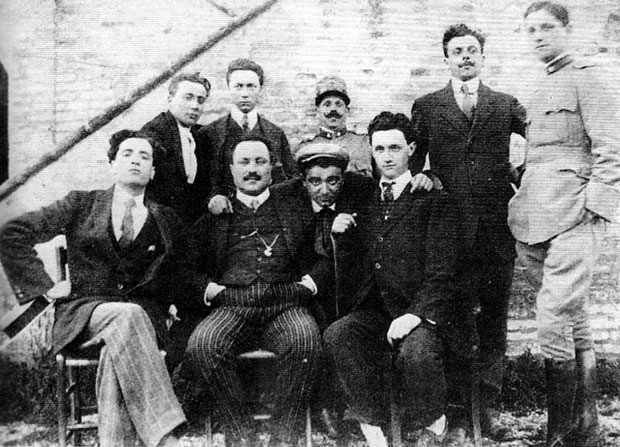Education
Bruno Ginanni Corradini, the second of four children, was born in 1892 in Ravenna, two years after the birth of his brother Arnaldo. His name, chosen by his father, Count Tullio Ginanni Corradini, a lawyer and also mayor of the city, is to be considered a tribute to Giordano Bruno. The nickname Corra, like that of his brother Ginna, was devised around 1914 by the painter Giacomo Balla with the purpose of ‘energizing’ his surname thanks to its assonance with the word ‘correre’ (to run). Bruno stayed faithful to it through unbridled ‘running’ from literature to art and cinema to theatre, making gymnastics an important and constant element of his life, thanks to continuous exercise and above all mindfulness training.

The lives of Bruno and Arnaldo, especially during their youth, run parallel but also intertwine, making it impossible to read them separately. The two brothers spent their youth between Ravenna, where Bruno applied himself to literary studies, while Arnaldo enrolled in art studies, and, during summer holidays, the family villa in Campiano. Since a very young age, Arnaldo and Bruno exhibited a restless, rebellious character, typical of the generation they were a part of, a generation that, having been born in the turn of the 19th century, was harshly projecting its ideas at the gates of the new century.
The two brothers combine their regular studies with more anarchic ones, showing interest in all that is knowable: literature, art, philosophy and theosophy. Their youth is dedicated to a continuous preparation for tomorrow, through exercises of the mind, body and soul. They are aided in this by readings from Eastern and Greek philosophy and the major works of great artists and poets, such as Rousseau, Schopenhauer, Goethe, Aristotle, Leonardo and Descartes. They take up Pythagoras’ motto ‘know thyself’ and Hugo’s maxim ‘thought is strength’.
The close relationship between Bruno and Arnaldo during their childhood and adolescence years clearly mark their subsequent artistic and literary production. It was a relationship that was not simply fraternal but above all intellectual, which leads them to a desire for knowledge and therefore the study of the classics of literature, philosophy, foreign languages and less ‘classical’ subjects such as occult sciences, innovative theatrical sciences, oriental philosophies and alternative medicine. It is important to note the attention they devote to Theosophy and later to the anthroposophical thought of Rudolf Steiner. In fact, the brothers attended the conferences of the Theosophical Society in Bologna, where they met intellectuals who were connoisseurs of the subject matter.
At the beginning of the 20th century, Ravenna was a quiet, still city, rooted in its traditions. It is therefore easy to understand how the two brothers, still little more than boys, managed to scandalize their well-thinking fellow citizens with the publication of their first theoretical texts in 1910.
The study of foreign languages enabled Bruno and Arnaldo to travel abroad, especially to Paris and London, where they were able to expand their knowledge of both ancient art and contemporary European trends. This cultural enrichment is the basis for the evolution of their thought, which starts from the comparison of the various orientations of artistic disciplines, together with the transposition of anthroposophical and steinerian themes, to arrive at a true knowledge of the supersensitive natural world.
The Ginanni Corradini brothers’ friendships, during their youthful years, with the likes of the actor Luigi Savini and the musician Francesco Balilla Pratella, are also important. It was precisely the latter that was to link the two brothers with Filippo Tommaso Marinetti, and thus with the Futurist Movement.
Text by Lavinia Russo, supervision by Lucia Collarile.
